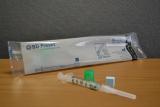Test Directory
Blood Gases (H+, pCO2, pO2, bicarbonate, Base Excess, Lactate
Containers - Adult

Gas Syringe
|
Volume Range
Full
Additive per Container
Heparin |
Containers - Child

Capillary Tube
|
Volume Range
65 µL
Additive per Container
Capillary must be heparinised. |
Reference ranges
Adult (arterial):
H+: 35 - 45 nmol/L
pH: 7.35 - 7.45
pCO2 male: 4.67 - 6.40 kPa
pCO2 female: 4.27 - 6.00 kPa
pO2: 11.1 - 14.4 kPa
Bicarbonate: 21 - 29 mmol/L
Base Excess: -2.0 - +3.0 mmol/L
Std Bicarbonate: 21-29 mmol/L
Lactate (arterial): 0.5 - 1.6 mmol/L. Lacate (venous): 0.6 - 2.4 mmol/L
Oxygen saturation: 95 - 99 %
Paediatric (arterial):
H+ <3 yrs: 34 - 48 nmol/L
H+ 3-18 yrs: 35 - 43 nmol/L
pCO2 < 3yrs: 3.8 - 5.5 kPa
pCO2 3-18 yrs: 4.2 - 5.7 kPa
pO2 <3 yrs: 8.0 -14.0 kPa
pO2 3-18 yrs: 10.0 - 14.0 kPa
Bicarbonate <3yrs: 17 - 25 mmol/L
Bicarbonate 3-18 yrs: 19 - 27 mmol/L
Laboratory Site
Old Dalkeith Road
Edinburgh
EH16 4SA
Howden
Livingston
West Lothian
EH54 6PP
Edinburgh
EH4 2XU
Transport arrangements
Avoid use of air tube.
Special instructions for collection
Expel air bubbles from the syringe and mix by gentle inversion. Remove needle and cap syringe. Samples should reach lab within 30 minutes and not be iced but kept at room temperature.
Anticipated turnaround
2 hours
General additional information
Point-of-Care testing for blood gases includes all of the above plus the following:
Sodium: 135 - 145 mmol/L
Potassium: 3.6-5.0 mmol/L
Chloride: 95-107 mmol/L
Ionised Calcium: 1.15-1.29 mmol/L
Anion gap: 10 - 20 mmol/L
Glucose (blood): mmol/L
Bilirubin: 0 - 21 µmol/L
Oxyhaemoglobin: 94 - 98 %
Carboxyhaemoglobin: 0 - 1.5 %
Methaemoglobin: 0 - 1.5 %
Lactate: Possible interference from ethylene glycol on lactate (Point-of-care blood gas analyser). Confirm unexpectedly high results by sending plasma lactate sample to Biochemistry laboratory.